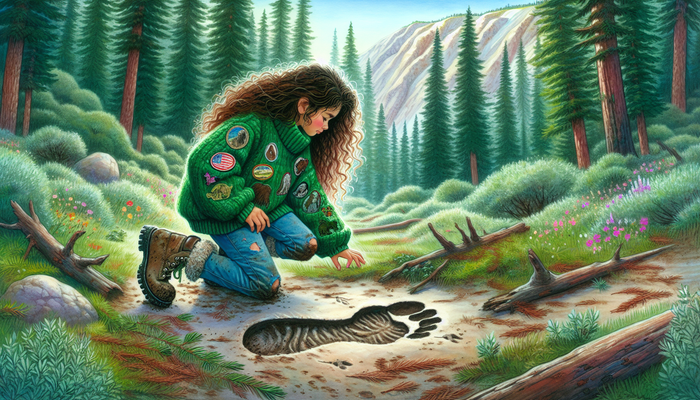The Yeti in Himalayan Traditions and Beliefs: Myth or Reality?

By Oliver Bennett, Cryptozoologist
Origins of the Yeti Legend
The word "Yeti" itself is a doorway into the complex world of Himalayan languages and cultures. Derived from the Sherpa words "yeh-teh," meaning "small, man-like animal," or "metoh-kangmi," translating to "man-bear snowman," the very name of this creature reflects its dual nature as both a physical being and a spiritual entity. This linguistic root offers our first clue that the Yeti is more than just a simple monster story – it's a concept deeply embedded in the worldview of the Himalayan people.
The Yeti's origins stretch back into the mists of pre-Buddhist beliefs, where it played a significant role in the spiritual landscape of various Himalayan cultures. Among the Lepcha people, indigenous to the Sikkim region, there existed a profound reverence for a being known as the "Glacier Being." This entity was not merely a creature of flesh and blood, but a powerful spirit that held sway over the success of hunting expeditions and the fate of those who ventured into the mountains.
As Buddhism spread its influence across the Himalayan region, the concept of the Yeti didn't disappear. Instead, it underwent a fascinating transformation, becoming integrated into the rich tapestry of Tibetan Buddhist cosmology. In this new context, the Yeti took on the role of a protector of the mountains, a being that straddled the line between the physical and spiritual realms. This evolution speaks to the remarkable adaptability of the Yeti concept, able to maintain its relevance even as the dominant religious paradigm shifted.
The Yeti in Tibetan Buddhism
In the realm of Tibetan Buddhism, the Yeti occupies a unique and multifaceted position. Far from being a simple beast or demon, the Yeti is often portrayed as a sentient being capable of following the path of Dharma. This elevated status places the Yeti in a category all its own – neither fully human nor entirely animal, but a creature with the potential for spiritual growth and enlightenment.
One of the most compelling aspects of the Yeti's role in Tibetan Buddhism is its association with important religious figures. Tales abound of Yetis serving as protectors and even disciples to revered lamas and spiritual masters. Perhaps the most famous of these stories is that of Lama Sangwa Dorje, a revered Buddhist master who lived in the 17th century. According to legend, Sangwa Dorje was cared for by a Yeti during his extended periods of meditation in remote caves. The Yeti is said to have brought the lama food, water, and fuel, demonstrating not only physical strength but also a capacity for compassion and service.
This relationship between the Yeti and spiritual practitioners extends beyond individual stories. In many Tibetan Buddhist traditions, the Yeti is seen as a guardian of sacred spaces, protecting monasteries and holy sites from negative influences. This protective role is often depicted in religious art, where Yeti figures can be found alongside other mythical creatures and deities.
The Yeti's significance in Tibetan Buddhism is perhaps most vividly illustrated in certain rituals and ceremonies. During the Dumche ceremonies, for example, a figure known as the gyamakag takes on the role of a Yeti. Dressed in a conical hat said to be made from Yeti scalp and wearing a sheepskin coat turned inside out, this figure guards the entrance to the monastery. The gyamakag's purpose is to ward off evil spirits, which are said to be terrified of Yetis. This ritualistic embodiment of the Yeti underscores its perceived power as a force for good, capable of confronting and dispelling negative energies.
Cultural Significance and Symbolism
The Yeti's influence extends far beyond the realm of religious belief, permeating the everyday lives and cultural practices of Himalayan communities. In many ways, the Yeti serves as a powerful symbol of the untamed wilderness that surrounds these mountain societies, embodying both the dangers and the spiritual potency of the natural world.
One of the most intriguing aspects of Yeti lore is its function as a cautionary figure. Much like the boogeyman of Western folklore, stories of the Yeti are often used to instill a healthy respect for the dangers of the wilderness in children and adults alike. Parents might warn their children not to wander too far from the village, lest they encounter the fearsome Yeti. These tales serve a practical purpose, helping to keep community members safe in an environment where straying too far can indeed be life-threatening.
But the Yeti is not merely a figure of fear. In many traditions, it also represents the profound connection between humans and the natural world. The creature is often depicted as possessing both human and animal traits, symbolizing the blurred line between civilization and wilderness. This duality reflects the complex relationship that Himalayan peoples have with their environment – one of both reverence and caution.
In Bhutan, where the Yeti is known as "migoi" or "strong man," the creature holds a particularly significant place in the national consciousness. Bhutanese folklore is rich with tales of the migoi, describing it as a powerful being capable of incredible feats of strength and endurance. These stories often emphasize the migoi's role as a protector of the forest and its creatures, aligning with Bhutan's strong environmental ethos.
The Bhutanese government has taken the unusual step of officially recognizing the potential existence of the Yeti. In 1998, they established the Sakteng Wildlife Sanctuary, a protected area that, among its stated purposes, includes providing a haven for the migoi. This official acknowledgment of the Yeti's possible existence blurs the line between folklore and conservation policy, demonstrating the deep integration of traditional beliefs into modern Bhutanese society.
The cultural significance of the Yeti extends to its role in shaping the identity of Himalayan communities. In a region where life is often defined by the harsh realities of mountain existence, the Yeti represents a link to the mystical and the unknown. It serves as a reminder that even in an age of scientific understanding, there are still mysteries in the world – a concept that resonates deeply with many Himalayan people.
Sightings and Expeditions
The allure of the Yeti has drawn explorers, adventurers, and scientists to the Himalayas for decades, each hoping to be the one to finally prove – or disprove – the creature's existence. These expeditions have not only shaped our understanding of the Yeti legend but have also contributed significantly to our knowledge of the Himalayan region itself.
One of the most famous early accounts comes from British explorer Eric Shipton. In 1951, while on an expedition to scout routes for climbing Mount Everest, Shipton and his team came across a set of large, unusual footprints in the snow at an altitude of about 19,000 feet. Shipton photographed these prints, placing his ice axe next to them for scale. These images, known as the "Shipton Prints," would become some of the most iconic and controversial pieces of evidence in the history of Yeti research.
The Shipton Prints sparked a wave of interest in the Yeti, leading to numerous expeditions in the following years. In 1953, Sir Edmund Hillary and Tenzing Norgay reported seeing large, unexplained footprints during their historic ascent of Mount Everest. Hillary, however, would later become skeptical of the Yeti's existence, highlighting the complex and often contradictory nature of Yeti evidence.
The 1950s saw a surge in Yeti-hunting expeditions, many of them sponsored by newspapers and scientific institutions. The Daily Mail, a British newspaper, funded several high-profile searches, including the 1954 Daily Mail Snowman Expedition. These expeditions, while failing to provide conclusive proof of the Yeti's existence, did much to popularize the legend and bring it to a global audience.
One of the most intriguing artifacts to emerge from this period was the so-called "Pangboche Hand." In 1958, an expedition led by American oil tycoon Tom Slick obtained what was purported to be the mummified hand of a Yeti from a monastery in Pangboche, Nepal. The hand, along with a supposed Yeti scalp from another monastery, became the subject of intense scientific scrutiny and debate.
The fervor surrounding Yeti expeditions reached such a pitch that in 1959, the U.S. State Department issued a set of official guidelines for American expeditions searching for the creature. These regulations, which included rules about obtaining permits and not harming the Yeti except in self-defense, demonstrate the seriousness with which the search was taken at the highest levels of government.
In more recent years, the search for the Yeti has taken on a more scientific character, with researchers employing modern technologies and methodologies in their investigations. DNA analysis, in particular, has become a crucial tool in examining purported Yeti remains and artifacts.
Despite the lack of conclusive evidence, these expeditions have had a lasting impact on our understanding of the Himalayan region. They have contributed to our knowledge of the area's geography, wildlife, and cultures. Moreover, they have kept the mystery of the Yeti alive in the public imagination, ensuring that this enigmatic creature continues to captivate and inspire.
Scientific Investigations
As the legend of the Yeti captured the world's imagination, it also caught the attention of the scientific community. Researchers from various fields – including zoology, anthropology, and genetics – have applied rigorous scientific methods to investigate the Yeti phenomenon. These studies have not only shed light on the possible origins of the Yeti legend but have also contributed to our understanding of Himalayan wildlife and ecosystems.
One of the most significant developments in Yeti research has been the application of DNA analysis to purported Yeti samples. In 2013, a groundbreaking study led by geneticist Bryan Sykes of the University of Oxford examined hair samples attributed to the Yeti. The results were surprising: while most of the samples were found to come from known animals such as bears, two samples matched the genetic signature of an ancient polar bear jawbone dating back 40,000 to 120,000 years.
This finding led Sykes to propose a fascinating hypothesis: that the Yeti legend might be rooted in the presence of a hybrid species of bear in the Himalayas, possibly a cross between brown bears and the descendants of ancient polar bears. While this theory doesn't confirm the existence of the Yeti as traditionally described, it offers a plausible explanation for some Yeti sightings and suggests that there may indeed be an undiscovered or rare species in the region.
However, subsequent studies have challenged Sykes' findings. A 2017 study published in the Proceedings of the Royal Society B analyzed nine purported Yeti specimens, including bone, tooth, skin, hair, and fecal samples. The researchers found that eight of the samples came from various species of bears native to the region, while one was from a dog. This study highlights the complexity of Yeti research and the importance of rigorous scientific methodology in investigating cryptozoological claims.
The scientific investigation of the Yeti has extended beyond genetics. Anthropologists and wildlife biologists have conducted field studies in the Himalayas, attempting to reconcile local accounts of the Yeti with known wildlife populations. These studies have often focused on the possibility that Yeti sightings might be misidentifications of known animals, particularly bears.
The Himalayan brown bear and the Tibetan blue bear have been suggested as possible sources for Yeti sightings. These bears are capable of standing on their hind legs and, when seen from a distance or in poor visibility conditions, could potentially be mistaken for a bipedal, ape-like creature. The rare and elusive nature of these bears in some parts of their range could contribute to the mystique surrounding Yeti sightings.
Another intriguing hypothesis proposes that the Yeti legend might be a cultural memory of extinct megafauna. Some researchers have suggested that stories of the Yeti could be rooted in encounters with now-extinct species such as the giant ape Gigantopithecus, which is known to have inhabited parts of Asia until relatively recently in evolutionary terms. While this theory is speculative, it highlights the potential for folklore to preserve information about the distant past.
Despite these scientific investigations, the Yeti remains an enigma. While many purported Yeti samples and sightings have been explained through conventional means, the legend persists. This persistence speaks to the power of the Yeti as a cultural symbol and to the human fascination with the unknown.
The scientific study of the Yeti also raises important questions about the relationship between traditional knowledge and modern science. While scientific investigations have failed to confirm the existence of the Yeti as described in folklore, they have revealed fascinating insights into the biodiversity and evolutionary history of the Himalayan region. This underscores the potential value of taking folklore seriously as a starting point for scientific inquiry, even if the results challenge the literal truth of the stories.
The Yeti in Popular Culture
The legend of the Yeti has transcended its Himalayan origins to become a global cultural phenomenon. From literature and film to advertising and tourism, the image of the mysterious mountain creature has captured imaginations worldwide, evolving and adapting along the way.
In Western popular culture, the Yeti – often referred to as the Abominable Snowman – first gained widespread attention in the mid-20th century. The creature became a staple of adventure stories, cryptozoology books, and sensationalist newspaper articles. Authors like H.P. Lovecraft incorporated Yeti-like beings into their fiction, adding to the mystique surrounding the creature.
Hollywood quickly recognized the cinematic potential of the Yeti. The 1957 film "The Abominable Snowman," starring Peter Cushing, was one of the first to bring the creature to the big screen. Since then, the Yeti has appeared in countless films and television shows, often portrayed as a fearsome monster but sometimes as a misunderstood or even friendly creature.
This softer side of the Yeti is particularly evident in children's entertainment. The character of Bumble in the classic 1964 TV special "Rudolph the Red-Nosed Reindeer" presented a more sympathetic version of the Abominable Snowman, setting a trend that continues in modern animated films like "Monsters, Inc." (2001) and "Smallfoot" (2018). These portrayals often play with the idea of the Yeti as an outsider, misunderstood by those who fear it – a theme that resonates with audiences young and old.
The Yeti has also made its mark in the world of advertising and branding. Perhaps the most famous example is the cooler company YETI, which has built its brand around the idea of rugged durability associated with the legendary creature. This commercial use of the Yeti image demonstrates how deeply the concept has penetrated popular culture, becoming shorthand for anything tough, mysterious, or associated with extreme environments.
In the realm of cryptozoology and paranormal research, the Yeti holds a special place alongside other legendary creatures like Bigfoot and the Loch Ness Monster. Numerous television shows and documentaries have been produced exploring the possibility of the Yeti's existence, often featuring dramatic reenactments of alleged sightings or expeditions into the Himalayas in search of evidence.
The internet age has brought new life to the Yeti legend, with countless websites, forums, and social media accounts dedicated to discussing and debating the creature's existence. Viral hoaxes and manipulated images purporting to show evidence of the Yeti regularly make the rounds online, demonstrating the enduring appeal of the mystery in the digital era.
Tourism in the Himalayan region has also been significantly impacted by the Yeti legend. Many trekking companies offer "Yeti-themed" expeditions, promising adventurers the chance to follow in the footsteps of famous Yeti hunters or to explore areas associated with Yeti sightings. Souvenir shops in Nepal and Bhutan often feature Yeti-themed merchandise, from t-shirts to carved wooden figures.
In 2019, the Indian Army caused a stir on social media when it claimed to have found Yeti footprints near the base camp of Mount Makalu. While the claim was met with skepticism from scientists, it demonstrates how the Yeti continues to capture public attention and spark debate.
The Yeti's journey through popular culture reflects broader societal trends and attitudes. In the mid-20th century, when much of the Himalayan region remained unexplored by Westerners, the Yeti represented the allure of the unknown and the possibility of undiscovered wonders. As scientific knowledge has advanced and the world has become more interconnected, the Yeti has increasingly come to symbolize the tension between rationality and mystery, between the explained and the unexplained.
Modern Interpretations and Controversies
As the Yeti has evolved from a figure of local folklore to a global cultural icon, it has become the subject of intense debate and controversy. These discussions touch on issues of cultural appropriation, the commodification of traditional beliefs, and the complex relationship between indigenous knowledge and Western scientific paradigms.
One of the primary controversies surrounding the modern interpretation of the Yeti revolves around the commercialization of the legend. While Yeti-themed tourism and merchandise have brought economic benefits to some Himalayan communities, critics argue that this commercialization trivializes deeply held cultural beliefs and reduces complex spiritual concepts to simplistic caricatures.
In Nepal, for example, the government has embraced the Yeti as a mascot for tourism campaigns, even going so far as to use Yeti Airlines as the name for one of the country's domestic carriers. While these efforts have undoubtedly raised the profile of Nepal as a tourist destination, some locals feel that they misrepresent the true nature of the Yeti in their cultural traditions.
The debate over the Yeti's representation extends to the realm of visual culture. Many modern depictions of the Yeti, particularly in Western media, portray the creature as a white, ape-like being. However, this image is at odds with traditional descriptions from Himalayan folklore, which often describe the Yeti as having reddish-brown fur. This discrepancy has led to accusations of cultural insensitivity and a failure to respect the authentic roots of the legend.
Another point of contention is the way in which Western scientific investigations of the Yeti have sometimes dismissed or marginalized local beliefs and knowledge. While scientific studies have provided valuable insights into the possible origins of Yeti sightings, some argue that these approaches fail to fully appreciate the cultural and spiritual significance of the Yeti to Himalayan peoples.
This tension between scientific rationalism and traditional belief systems is particularly evident in discussions about conservation. The case of Bhutan's Sakteng Wildlife Sanctuary, established in part to protect the habitat of the migoi (Bhutan's version of the Yeti), raises interesting questions about the role of cultural beliefs in conservation efforts. While some conservationists applaud the use of traditional beliefs to promote environmental protection, others worry that basing conservation policies on unproven creatures could undermine scientific credibility.
The Yeti has also become entangled in broader debates about cryptozoology and its place in modern science. While many scientists dismiss the search for creatures like the Yeti as pseudoscience, others argue that the investigation of cryptids can lead to genuine scientific discoveries. The identification of new species and the rediscovery of animals thought to be extinct provide some support for this view, although conclusive evidence for the existence of the Yeti remains elusive.
In recent years, there has been a growing movement to reexamine the Yeti legend through an indigenous lens, emphasizing the importance of understanding the creature within its original cultural context. This approach seeks to move beyond the binary of "real or not real" to explore the ways in which the Yeti functions as a powerful symbol and repository of traditional ecological knowledge.
Some scholars have proposed that the Yeti serves as a kind of "boundary creature," embodying the complex relationships between humans, animals, and the environment in Himalayan cosmology. From this perspective, debates about the literal existence of the Yeti miss the point; instead, the focus should be on understanding the role that such beings play in shaping human interactions with the natural world.
The controversy surrounding the Yeti also touches on issues of intellectual property and cultural heritage. As Western companies increasingly use Yeti imagery and concepts in their branding and products, questions arise about who has the right to profit from these cultural symbols. Some indigenous rights advocates have called for greater protection of traditional knowledge and cultural expressions, including folklore creatures like the Yeti.
As we move further into the 21st century, the interpretation and representation of the Yeti continue to evolve. Digital technologies and social media have created new platforms for sharing and debating Yeti lore, while also facilitating the rapid spread of misinformation and hoaxes. At the same time, increased global awareness of indigenous rights and cultural sensitivity has led to more nuanced discussions about the appropriate ways to engage with traditional beliefs and stories.
The ongoing fascination with the Yeti speaks to a deep-seated human desire for mystery and wonder in an increasingly mapped and explained world. Whether seen as a literal creature, a spiritual entity, or a complex cultural symbol, the Yeti continues to challenge our understanding of the relationship between humans and the natural world, between science and tradition, and between the known and the unknown.
Conclusion
As we've journeyed through the misty peaks and hidden valleys of Yeti lore, we've encountered a creature that is far more than a simple monster or myth. The Yeti emerges as a complex figure, deeply woven into the cultural, spiritual, and ecological fabric of the Himalayan region. It serves as a powerful symbol of the untamed wilderness, a guardian of ancient wisdom, and a bridge between the physical and spiritual realms.
From its origins in pre-Buddhist beliefs to its current status as a global pop culture icon, the Yeti has demonstrated a remarkable ability to adapt and evolve. It has survived the transition from oral tradition to scientific scrutiny, from local legend to international sensation. In doing so, it has retained its power to captivate imaginations and spark debates about the nature of reality and the limits of human knowledge.
The scientific investigations into the Yeti, while failing to provide conclusive proof of its existence as traditionally described, have nonetheless yielded valuable insights into the biodiversity and evolutionary history of the Himalayan region. These studies remind us that the search for mythical creatures can lead to very real discoveries, highlighting the potential value of taking folklore seriously as a starting point for scientific inquiry.
At the same time, the commercialization and popularization of the Yeti have raised important questions about cultural appropriation and the commodification of traditional beliefs. These controversies challenge us to consider how we can engage with indigenous knowledge and folklore in ways that are respectful and mutually beneficial.
Perhaps the true value of the Yeti lies not in proving or disproving its physical existence, but in what it reveals about our relationship with the natural world and our endless fascination with the unknown. In a world where it can sometimes feel like every mystery has been solved and every corner of the globe explored, the Yeti stands as a reminder that there is still wonder to be found, still secrets to be uncovered.
As we conclude our exploration, we're left with more questions than answers – and perhaps that's exactly as it should be. The Yeti, whether real or mythical, continues to roam the peaks of our imagination, challenging us to look beyond the boundaries of the known and to consider the profound mysteries that still exist in our world.
In the end, the story of the Yeti is our story – a tale of human curiosity, of our complex relationship with nature, and of our eternal quest to understand the world around us and our place within it. As long as there are unexplored corners of the world and unanswered questions in our hearts, the legend of the Yeti will endure, inviting us to venture into the unknown and to keep our minds open to the wonders that might be waiting just beyond the next mountain peak.
From Bigfoot to UFOs: Hangar 1 Publishing Has You Covered!
Explore Untold Stories: Venture into the world of UFOs, cryptids, Bigfoot, and beyond. Every story is a journey into the extraordinary.
Immersive Book Technology: Experience real videos, sights, and sounds within our books. Its not just reading; its an adventure.



























